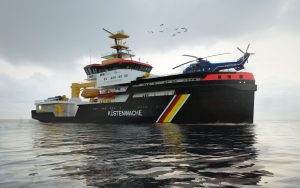Voith equips German multi-purpose vessels with Inline Thrusters
 On behalf of the German government, Lemwerder-based shipbuilder Abeking & Rasmussen Schiffs- und Yachtwerft (A&R) is building three multi-purpose vessels for use in German waterways. The Ship Technology Department at the BAW (German Federal Waterways Engineering and Research Institute) is responsible for planning and design, tendering, and ongoing construction management.
On behalf of the German government, Lemwerder-based shipbuilder Abeking & Rasmussen Schiffs- und Yachtwerft (A&R) is building three multi-purpose vessels for use in German waterways. The Ship Technology Department at the BAW (German Federal Waterways Engineering and Research Institute) is responsible for planning and design, tendering, and ongoing construction management.
Over the next three years, the more than 90m long vessels commissioned by the German Federal Waterways and Shipping Administration will replace three older ships. Each vessel will have LNG (liquefied natural gas) powered engines with a total output of 12,000kW. As bow thrusters, all three ships will be equipped with a Voith Inline Thruster (VIT) 1,650 with an input power of 900kW. “We are extremely pleased that Abeking & Rasmussen is reinforcing our excellent collaboration by relying on proven Voith technology for this order as well”, says Oliver Lenz, Sales Application Manager at Voith. The VIT has already proven effective in many offshore supply ships, cruise liners and luxury yachts. Their owners, crews and passengers appreciate the propulsion concept thanks to its very low running noise and fast responsiveness to steering commands that enables precise dynamic positioning. Both these benefits were crucial factors in the decision by the shipyard, supervising agency and operator to award the contract to Voith, because the multi-purpose vessels will have a landing pad for helicopters on the bow as well as a winching area on the stern.
The precise dynamic positioning facilitated by the VIT helps to bring people and materials safely on board using these two routes. Another argument in favor of awarding the contract to Voith was the compact design of the VIT, which does not require either a drive shaft or gearbox. As the electric motor is directly integrated into the VIT, there is space in the hull directly above the engine, offering significant space benefits compared with conventional solutions. The design principle of the VIT also results in a more direct transfer of the propulsive power, which in turn increases the thrust and thus the efficiency, helping to reduce fuel consumption.






